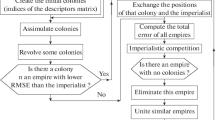Abstract
QSAR investigations of a series of 25 Octreotide drugs were performed using multiple linear regression (MLR) and artificial neural network (ANN) as modelling tools and simulated annealing (SA) and genetic algorithm (GA) as optimization methods. The obtained results were compared with each other and with the results of MLR–MLR approach in terms of correlation coefficient (R2) and root mean of square error (RMSE), from which the ANN–GA was found to be the best scheme. It was revealed that the activity of derivatives of Octreotide drugs depends majorly on HATS7v, SIC5, Mor24u, RDF010m, EEig06r, E1u, EEig02× descriptors in gas phase. The best Octreotide derivative (according to –log IC50) was exposed to reaction with Cu, Zn, Fe using B3lyp/lanl2dz to investigate the stability of the formed complexes, from which the copper complex was perceived to be the most stable one. In addition, CORAL software was employed to study the derivatives using the Monte Carlo method and correlation coefficient, cross-validated correlation coefficient and standard error of the model were checked out. It was concluded that simultaneous utilization of QSAR and Monte Carlo method can lead to a more comprehensive understanding of the relation between physicochemical, structural and theoretical molecular descriptors of drugs to their biological activities.





Similar content being viewed by others
REFERENCES
M. Lelle, S. Kaloyanova, C. Freidel, et al., Mol. Pharm. 12, 1 (2015).
I. M. Modlin, M. Pavel, M. Kidd, and B. I. Gustafsson, Aliment. Pharm. Ther. 31, 169 (2010).
P. Hovind, L. Simonsen, and J. Bülow, Clin. Physiol. Funct. Imaging 30, 141 (2010).
M. T. Keegan, Pharmacology and Physiology for Anesthesia, 2nd ed. (Elsevier, Amsterdam, 2019).
S. Kirkpatrick, Jr., C. D. Gelatt, and M. P. Vecchi, Science (Washington, DC, U. S.) 220, 671 (1983).
V. O. Černý, J. Optim. Theory Appl. 45, 41 (1985).
L. M. Schmitt, Theor. Comput. Sci. 259, 1 (2001).
D. Bertsimas and J. Tsitsiklis, Stat. Sci. 8, 10 (1983).
D. A. Winkler, Brief. Bioinform 3, 73 (2002).
E. Tanış, N. Çankaya, and S. Yalçın, Russ. J. Phys. Chem. B 13, 49 (2019).
A. P. Toropova, A. A. Toropov, E. Benfenati, G. Gini, D. Leszczynska, and J. Leszczynski, J. Comput. Chem. 32, 2727 (2011).
I. Iakovidis, I. Delimaris, M. Stylianos, and M. Piperakis, Mol. Biol. Int. 20, 1 (2011).
https://pubchem.ncbi.nlm.nih.gov/.
F. Kalantari Fotooh and M. Atashparvar, Russ. J. Phys. Chem. B 3, 1 (2019).
M. J. Frisch, G. W. Trucks, H. B. Schlegel, G. E. Scuseria, M. A. Robb, J. R. Cheeseman, G. Scalmani, V. Barone, B. Mennucci, G. A. Petersson, H. Nakatsuji, M. Caricato, X. Li, H. P. Hratchian, A. F. Izmaylov, et al., Gaussian 09 (Gaussian, Inc., Wallingford CT, 2009). https://gaussian.com/glossary/g09/.
J. H. Schuur, P. Selzer, and J. Gasteiger, J. Chem. Inf. Comput. Sci. 36, 334 (1996).
R. Todeschini and V. Consonni, Handbook of Molecular Descriptors (Wiley-VCH, Weinheim, 2000).
M. C. Hemmer, V. Steinhauer, and J. Gasteiger, J. Vibr. Spectrosc. 19, 151 (1999).
V. Consonni, R. Todeschini, and R. Pavan, J. Chem. Inf. Comput. Sci. 42, 682 (2002).
V. Consonni, R. Todeschini, M. Pavan, and P. Gramatica, J. Chem. Inf. Comput. Sci. 42, 693 (2002).
P. Gramatica, V. Consonni, and R. Todeschini, Chemosphere 38, 1371 (1998).
P. Gramatica, V. Consonni, and R. Todeschini, Chemosphere 41, 763 (2000).
SPSS, Version 19. http://www.spssscience.com. Accessed 2010.
M. H. Fatemi and S. Gharaghani, Bioorg. Med. Chem. 15, 7746 (2007).
K. Levenberg, Q. Appl. Math. 2, 164 (1944).
M. Jalali-Heravi and M. F. Parastar, J. Chem. Inf. Comput. Sci. 40, 147 (2000).
A. Mauri, V. Consonni, M. Pavan, and R. Todeschini, MATCH. Commun. Math. Comput. Chem. 56, 237 (2006).
MatLab, 2014a. Matlab: The Language of Technical Computing. https://ch.mathworks.com/products/matlab.html.
http://www.insilico.eu/coral.
O. G. Maksimova and A. V. Maksimov, Russ. J. Phys. Chem. B 11, 15 (2017).
A. M. Veselinovic, A. A. Toropov, A. P. Toropova, I. Damnjanovic, and G. M. Nikolic, Sci. J. Fac. Med. Niš 31, 95 (2014).
https://cactus.nci.nih.gov/translate/.
SMILES Tutorial: What is SMILES? (U. S. Environ. Protect. Agency, 2012).
R. SayyadikordAbadi, A. Alizadehdakhel, and S. Tajadodi Paskiabei, J. Korean Chem. Soc. 60, 225 (2016).
R. Sayyadikord Abadi and A. Alizadehdakhel, Rev. Roum. Chim. 63, 171 (2018).
R. Sayyadikord Abadi, A. Alizadehdakhel, and S. Dorani Shiraz, Russ. J. Phys. Chem. B 11, 307 (2017).
Yu. M. Sivergin, S. M. Kireeva, and S. M. Usmanov, Russ. J. Phys. Chem. B 9, 952 (2015).
A. Kumar and S. Chauhan, SAR QSAR Environ. Res. 28, 179 (2017).
A. Pal, B. Biswas, S. K. Mondal, C.-H. Lin, and R. Ghosh, Polyhedron 31, 671 (2012).
T. S. Lobana, G. Singh, and T. Nishioka, J. Coord. Chem. 57, 955 (2004).
G. T. King and N. E. Miller, J. Inorg. Chem. 25, 4309 (1986).
D. Chen and L. Powers, J. Inorg. Biochem. 58, 245 (1995).
C. Marzano, M. Pellei, F. Tisato, and C. Santini, Anti-Cancer Agents Med. Chem. 9, 185 (2009).
ACKNOWLEDGMENTS
The support for this study provided by the Islamic Azad University of Rasht and University of Guilan are gratefully acknowledged.
Author information
Authors and Affiliations
Corresponding author
Ethics declarations
The authors declare that they have no conflicts of interest.
Rights and permissions
About this article
Cite this article
Sayyadikord Abadi, R., Shojaei, A.F., Tatafei, F.E. et al. Theoretical Study of Octreotide Derivatives as Anti-Cancer Drugs using QSAR, Monte Carlo Method and formation of Complexes. Russ. J. Phys. Chem. B 16, 127–137 (2022). https://doi.org/10.1134/S199079312201002X
Received:
Revised:
Accepted:
Published:
Issue Date:
DOI: https://doi.org/10.1134/S199079312201002X




